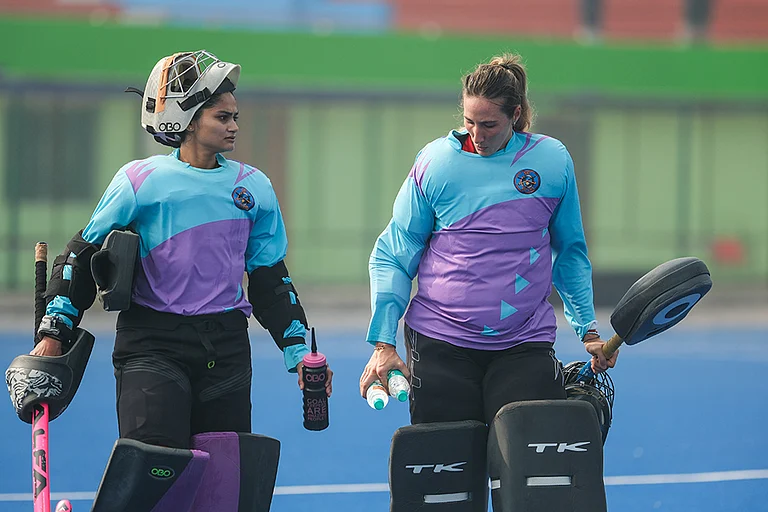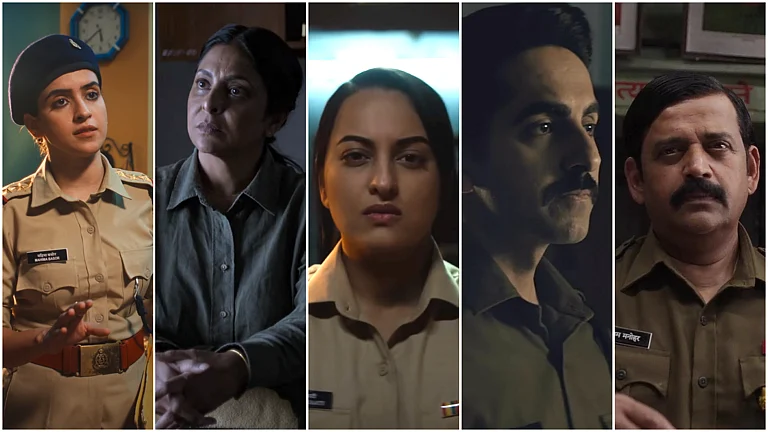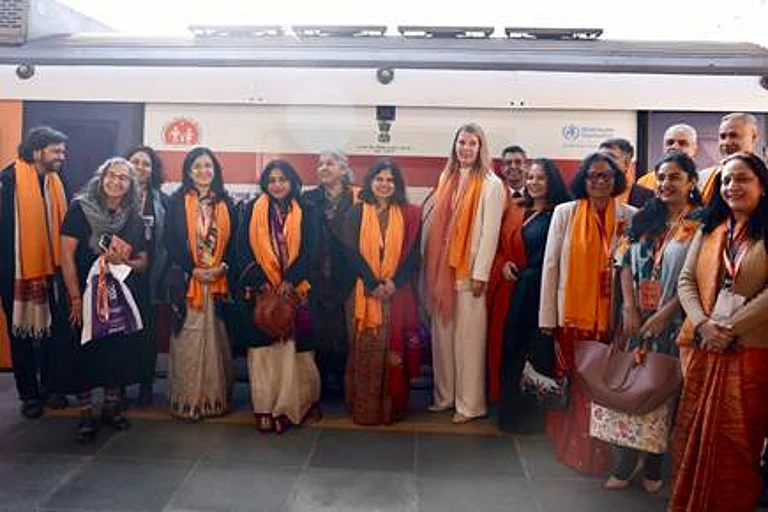Politics in India have remained male-centric for most of its discourse. The male dominance has also influenced many major political campaigns across the country. Showing leaders as strong decision-makers has remained an old theme of Indian politicians. This also reflects on the agendas these male leaders follow or the bills they introduce in the Parliament. For example – Narendra Modi has often been praised for his geopolitical approach, the campaign “chappan inch ka seena” has remained a popular hashtag across political twitter and other social media handles to describe how strong a leader is. Similarly, the tag line – “neta nahi, beta” has been used by many young male politicians on their posters and campaigns to seem accessible. But when it comes to women’s participation in politics and having campaigns for women voters and for women politicians, we have limited options. It remains a collective struggle as women (both voters and leaders) to have political participation.
Women’s Participation In Indian Politics: A Struggle Since 1951
Since the beginning of the first elections, women-centric campaigns have reduced women to homemakers. During the first election of India (1950-1952), women voters faced a challenge when it came to registering themselves. Many of the voter application forms added “wife of abc”, “daughter of xyz” instead of Name of the women on their voter ID. This prevented approximately 28 Lakh women from voting in the General Assembly Elections of 1951.
Despite having a woman Prime Minister in the past, often her contributions are overlooked and the emergency imposed by her in the past have been used as a tool by many MRAs and other folks to advocate against having women’s participation in politics. Over the last few decades, Indian politics has evolved a lot. Yet, with the waves of feminism increasing women’s participation in politics, there has also been a rise in the tokenism politics of political parties across the ideological spectrum.
Often, many parties choose women from known families, giving rise to nepotism. However, when this is done by men and for men, it is not criticised as much as their women counter-parts. Similarly, with the reservation at the panchayat level, women still must fight dual fights to assert themselves, i.e. as leaders during elections to win and to establish themselves and as decision-makers after winning the elections. Yet, in many parts of the country, despite women winning the panchayat elections, their husbands try to treat them as a signature and make decisions of their behalf. These dual fights put immense pressure on women to do something that their male colleagues do not even have to think about – the right to assert their free will, the right to political participation.
With rise of women’s participation in the last two decades, we are also seeing a slow rise in women-centric campaigns. One of the successful campaigns that centred around women’s issues was in the year 2012 after the harrowing December 26 rape case which shook Delhi and the country.
Not only did the campaigns and protests force the government to make a quick decision, it also led to the fall of INC in Delhi. Sheila Dixit drew severe criticism for not only ignoring women’s safety concerns but also for making insensitive remarks during the Saumya Vishwanathan murder case’s news coverage which happened in 2008. It raised concerns about the lack of seriousness of CM Sheila Dixit and the government both in the state and the centre at that time leading to the emergence of AAP as an option for Delhi voters later in 2013.
During the 2014 Elections, women safety remained an important issue for political parties. In the current scenario, women voters appeal for women safety. There are social welfare schemes that are promised to women mainly in the form of subsidies for gas, ration schemes, monthly cash for women, free bus rides and to distribute items such as laptops and phones. Although these issues are important for many working-class women, these schemes often reduce women voter’s issues and lead to further sexism by male politicians across the states. It is notable that such campaigns do not guarantee employment for women despite having reduced labour force participation for women. Neither has any major political party promised to reduce or address the increasing number of suicides among Indian housewives.
The Emergence Of Women-Centric Campaigns: For Women, By Women
In the recent times, we have witnessed women-centric campaigns for women leaders and women voters. During the 2014 General Assembly Elections the slogan, “Bahut hua naari par war, abh ki baar Modi Sarkar” was a famous slogan to raise issue of women’s safety across the country. “Beti Bachao Beti Padhao” (Save Daughters, Educate Daughters) has become a household slogan for many north Indian BJP voters after 2015 launch of the slogan in Haryana. This was seen as a proof of BJP being gender-sensitive. One of most popular political slogans for a candidate recently was – “Ladki Hu Ladd Sakti Hu” (I am a girl, I can fight) for Priyanka Gandhi from INC for Uttar Pradesh Assembly elections. The song of the same slogan became popular quickly. Before this, in 2021 Bengal Assembly Election, TMC’s slogan “Bangla Nijer Meyekei Chaye” (Bengal wants its own daughter) was popular and helped Mamta Banerjee to get re-elected. The campaigns designed for women leaders is often focussed on highlighting that women can be good leaders or are daughters of the soil. This has led to narratives about women as relatives – mother, sister, daughters to the voters rather than decision-makers.
Have things changed for women?
The question arises – have things changed for women? Or are women reduced to tokens of a party to show themselves as progressive. Currently, every national party has a women’s wing, many women leaders sit in the parliament as leaders and as opposition, yet are these women immune to misogyny and sexism? When it comes to politics, the sexism persists. Many women leaders are still fighting to be taken seriously as leaders in India. The challenges for women leaders range from online trolling to mass level character assassination. Whether it is BSP Leader and former UP CM Mayawati getting attacked by political rivals for not being “feminine enough” to Union Minister Smriti Irani being shamed for her personal life, women are not spared across political lines and caste lines. One of the infamous examples of sexism in politics is how a derogatory pamphlet against AAP’s Atishi Marlena was circulated in an East Delhi Constituency during the Elections of 2019. Back then, she was contesting from a constituency in east Delhi for MP. She is currently the MLA from Kalkaji constituency and is a minister of education, PWD and tourism in Delhi government. This is the similar and harsh reality for women voters, especially those who belong to the marginalised sections. They also witness workplace harassment and bullying by their male counterparts. Recently, statistics were shared by NCRB that there is rise in crime against women. There have been over more than 44.5 lakh registered cases of crimes against women in the year 2022. There has been a decline in the labour force participation of Indian women from 27.8 per cent in 2012 to 23.97 per cent in 2022.
The plight of transwomen and queer women remains like their cisgender heterosexual counterparts. Recently, Jane Kaushik, a Dalit transwoman was denied right to employment by a school in Uttar Pradesh. When she started applying to other schools, she was unable to get hired for months and had to fundraise to manage her living expenses. The horrible video from Manipur where two Kuki tribal women were paraded naked and harassed on the streets remains fresh in the memory of women across the states. It is one of the many cases of sexual harassment in the state that was under violence this year yet it is becoming a distant memory with the apathy of media and politicians both.
Apart from this, according to NCRB, there is a rise in crimes against Dalits. Dalit women face the worst of casteism and misogyny in the form of harassment, discriminatory behaviour, and dehumanisation. From Bhanwari Devi’s case to the current cases of crimes against Dalit women, the casteism amalgamated with misogyny has not ended.
The Demand For Women-Centric Campaigns Among Political Consultancies
With political consultancies coming to provide political PR to politicians in India, there is a small demand for women-centric campaigns by politicians. It is not limited to women leaders to have a demand for women-centric campaigns but also the male leaders who want to cater to the needs of women voters or to show themselves as an impressive candidate that shall be preferred over their rivals demanding women-centric campaigns. Often, these campaigns raise issues of the local women. Mostly, in the case of rural constituencies, it focuses on ration, LPG Cylinders, electricity, water supply, monthly money distribution, etc.
During the recent Rajasthan election campaign, former CM Ashok Gehlot launched two “guarantees” for women voters which focused on subsidised LPG Cylinders and promised 10,000 rupees to women head of the families. Before him, the guarantees of similar campaigns have been used in Karnataka and Himachal Pradesh Assembly elections promising free bus rides in Karnataka for women and promising “Har ghar Lakshmi, samman nidhi scheme” to provide 1500 rupees to women per month in Himachal Pradesh. In Himachal Pradesh, BJP introduced, “stree sankalp patra” a manifesto with promises to women ranging from providing financial support to pregnant women to interest-free loans to women running home stays in the hill state. In Delhi elections, AAP’s promise of making buses free for women did wonders for them. Many consultancies have started curating atleast one to two women-centric campaigns per client in every election to address interests of women in different constituencies.
Women Leaders And Their Agendas: How Far Are We When It Comes To Representation And Inclusion Of Women In Politics
With women reservation bill making headlines this year, the question of representation and inclusion becomes more important than ever. Women leaders exist across political parties and many hold important ministries under the current government of India but how far are we when it comes to inclusion of women in politics. Out of the 542 Lok Sabha members, we have 78 women in Lok Sabha and out of 224 Rajya Sabha members, we have 24 women in the Rajya Sabha, which does not even make it to the 50 per cent of representation in both the houses of the Parliament. Although BJP boasts of having highest women ministers in the last 17 years, the number for “highest” is low, i.e. 11 women are in the cabinet with only two holding cabinet position, i.e Finance Ministry headed by Nirmala Sitaraman and Women and Child Ministry headed by Smriti Irani. The percentage and statistics show that this representation is rather tokenistic in nature when it is compared to the number of men in both houses and having cabinet positions.
Apart from this, many women leaders that have made their mark in the mainstream politics are still struggling with patriarchy. Whether it is trolling of Bengal’s CM Mamta Banerjee for never marrying or the lack of support for CPI M’s K K Shailaja for the next term in Kerala as a minister, despite single-handedly managing the covid outbreak in the state.
The intersections of caste, gender and sexual orientation of women leaders in India tells a story about a long journey that women have to cover. In Chandoli district of Varanasi, when Sonu Kinnar, a transwoman, won a nagar pallika chairman election, a fight broke out between her supporters and BJP workers. It remains a challenge for queer women to get to contest elections and for many, voting is still a challenge due to documentation issues and abandonment of families which creates problems in having legal documentation. Apart from her, only a handful transwomen were able to contest elections, yet only one transwoman was able to become an MLA. In the case of Dalit-Bahujan and Adivasi women leaders, the casteist and elitist practices often overpower the people’s mandate. The current President of India, Draupadi Murmu faced massive trolling and racist remarks after becoming the president. A Dalit woman sarpanch was allegedly beaten up and her clothes were torn in Patiala. This year, a Dalit woman sarpanch was beaten up in Shivpuri district of Madhya Pradesh.
With all the struggle and change, what women can expect from leaders in India? Are they going to use women-centric campaigns to grab attention for a short time and on issues of LPG, ration, where they limit women to the household or they are also going to address that women are part of the public domain and deserve employment, safety from harassment, equal opportunities, equal political and social rights? Another question arises, are leaders listening across the party lines or are they trying to use a one-size-fits-all campaign approach for women voters?
It is possible that in the next ten years women’s representation may increase but it is also possible that it will be tokenistic and the leaders will suffer from misogynistic behaviour like they do right now. However, there is an emergence of having new form of women centric-campaigns that can be useful for both politicians and voters alike. But they do not seem enough until we provide equal respect and rights to the women leaders and voters. It becomes necessary to create a bigger table in the political domain to ensure that women across intersections get to sit on it and make decisions for the country.
(Meghna Mehra is the author of the book Mini Dictionary Of The LGBTQIA+ community and other books. She has a Master's Degree in Political Science, a PG Diploma in women and gender studies and is the founder of AIQA Foundation. Currently she is pursuing her master's in electoral management from TISS.)























